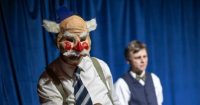Search the website

24th July 2025
From Ancient Greece to the West End stage, the relevance of theatrical mask making continues to shape how stories are told onstage. More than just costume pieces, they are storytelling tools. Masks help actors shift between characters, express emotions and represent themes that go beyond language or time.
What Is Theatrical Mask Making and Why Does It Matter?
Theatrical masks continue to be a powerful tool for actors and designers. Like mime, they help actors focus on body, voice and movement, whilst also making stories more visual and universally understood. With the face hidden, every gesture becomes important, which sharpens both the performance and the audience’s focus.
Masks can also help unify a story’s message. By stripping away individual features, they allow performers to represent an emotion or idea that feels shared, even ancient. This makes mask work a valuable skill for anyone interested in physical theatre, puppetry or devised performance.

BOVTS Macbeth Production 2021-2022
The Historical Relevance of Theatrical Mask Making
Masks have always had a place in performance. In Ancient Greek theatre, actors wore large, stylised masks. These helped project emotion to huge audiences and made characters easy to recognise.
In Japan, Noh theatre dates back to the 14th century. Performers use finely carved wooden masks to represent spirits, animals and historical figures. With small movements and precise posture, these masks show complex emotions.
More recently, productions like The Lion King have shown how masks can create strong visual worlds on stage. Inspired by myth and ritual, these designs help blur the line between actor and character.

Modern Approaches to Mask Making in Performance
While traditional mask-making techniques such as leatherwork and papier mâché remain in use, modern practices have evolved. Thermoplastics like Worbla are now widely used in contemporary scenic arts due to their safety, flexibility and durability, making them ideal for both workshops and live productions.
Today, designers draw inspiration from global traditions, often blending classic methods with innovative approaches. With a wide variety of designs now available, you will find everything from stylised realism to abstract creations across theatre, education and film.

© Disney. Photo by Deen van Meer & The Lion King Joan Marcus
Learn More About the Relevance of Theatrical Mask Making
If you’re curious about this powerful craft, our four-day Theatrical Mask Making course is a great place to start. Led by our Props Supervisor and Tutor, Louise Thomas, the course explores the history, styles and techniques of mask making.
You’ll sculpt, cast, and finish your own theatrical mask—and take home a reusable mould to keep creating. No previous experience is needed, you’ll cover all the fundamentals over the four days (as seen below), just bring your imagination!

